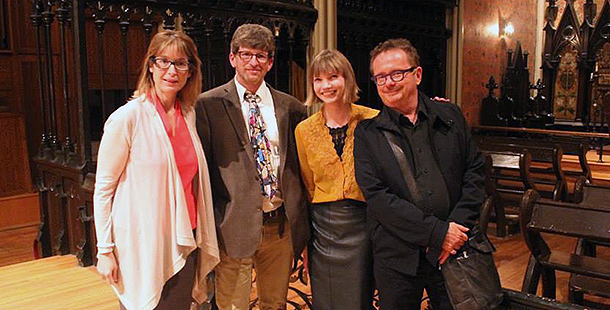Collective look at vanished ward paints a picture of immigration in 1840s downtown

THE WRITERS OF HISTORY: From left, Ellen Scheinberg, John Lorinc, Tatum Taylor and Michael McClelland captured the essence of downtown Toronto, from Yonge to University, and College to Queen, in their non-fiction book, The Ward.
Hillcrest Village resident John Lorinc narrates a provocative tale, while on the phone, of a mid-19th century alderman in Toronto, looking out an office window at (Old) City Hall.
In the politician’s eyes there lies a slum covering the landscape from University Avenue to Yonge Street and College Street to Queen Street, and it must be redeveloped.
That block of land, now rife with hospitals and a huge shopping mall was once home to Toronto’s diverse immigrant population during the 1850s.
It was also the subject of the book that journalist Lorinc collaborated on with fellow history buffs and editors — Michael McClelland, Ellen Scheinberg and Tatum Taylor — titled The Ward: The Life and Loss of Toronto’s First Immigrant Neighbourhood.
Their collaborative efforts of an architect, historian and a journalist won them the Award of Excellence from Heritage Toronto in October.
“I’m very proud of that book. It was an incredibly rewarding experience to work with the contributors,” Lorinc said. “I’ve been a journalist since 1988, and this was the highlight of my professional career.”
He teamed up with Davisviller Michael McClelland and Scheinberg, a resident of Bathurst and Lawrence, three years ago, after writing a piece for the Toronto Star right around the Doors Open festival.
“The premise of the piece was it would be nice if there were doors to open,” he said. “There’s all this rich history there, but there are no doors to open. It’s all gone.”
Those slums located in that chunk of downtown were torn down in and the Discovery District, Nathan Philips Square and the Eaton Centre now cover the land.
What Lorinc realized, of all the buildings the city protects, it’s always the ones built by rich people that it preserves. So, the original idea he had was to open a tenement museum, much like in New York City. However, the topic of a book came up, and the quartet went to work.
A variety of voices help shape the stories of African American refugees fleeing slavery, Irish immigrants escaping the potato famine, Italians, whose country was in economic turmoil, the Jewish fleeing Russia, and Chinese migrant workers, avoiding the head tax.
“The story of the ward was very evocative because it’s all about immigration to Toronto,” Lorince said. “My parents were Hungarian refugees, and they came to Toronto and they had nothing at all.”
“That story is multiplied thousands and thousands of times in Toronto and, in many different forms, is expressed in the ward in a very concentrated way.”
Next on the agenda is writing a sequel to The Ward, in which the quartet will focus on an archaeological dig taking place on Centre Avenue, around the corner from the current City Hall.

